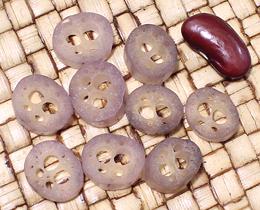 [genus Nymphaea (more than 35 species) of family Nymphaeaceae
in order Nymphaeales]
[genus Nymphaea (more than 35 species) of family Nymphaeaceae
in order Nymphaeales]
Water Lilies are often called "Lotus", but they are not at all related to the Lotus (family Nelumbo). The resemblance between the two is so striking even botanists were fooled until today's genetic methods were developed. Water lilies split off from other flowering plants at a very early time, thus are called "Basal Angiosperms". Lotus are within the much more modern order Proteales.
It is easy to tell the difference between Water Lilies and Lotus. The Water lily leaves float on the surface of the water and have a deep notch from the side to the center. Lotus leaves are round, held above the water and have no notch. Photo by Dieter Rabich distributed under license Creative Commons Attribution 4.0 International.
The Egyptian Blue Water Lily (Egyptian Blue Lotus; Nymphaea caerulea) flowers have a lightly psychoactive effect, mainly as a sedative. Petals and whole flowers of this plant are used to make teas and to flavor wine and martinis. One species, Nymphaea odorata subsp. tuberosa, native to the southeastern United States, produces potato-like tubers which can be cooked and eaten.
More on Order Nymphaeales.
Young leaves, flower buds, and flower stems can be cooked and eaten. The seeds are nutritious, high in starch, protein and oil. They can be roasted and popped like popcorn, or ground into flour.

 [genus Nymphaea]
[genus Nymphaea]
Recipes for Water Lily Stems are popular in Cambodia, Vietnam, Laos, and West Bengal and Assam in India. From photos, I see that the White Lotus is the variety most used. The stems are very long, the longest in the left photo was 5-1/2 feet, but they can be as long as 7 feet. They must reach from the root to the surface of the water or beyond. These photo specimen stems were 1/2 inch in diameter.
In Cambodia, Laos, and Vietnam these stems are most popular in soups. In India and Bangladesh they are most popular in curries or as pakora.
 [Victoria amazonica, Victoria cruziana, Victoria
mattogrossensis]
[Victoria amazonica, Victoria cruziana, Victoria
mattogrossensis]
These Water Lilies are very popular in botanical gardens, but I have seen
no mention they are used for food, though it is possible they are.
These water lilys have rimmed floating leaves sometimes exceeding 9 feet
across. V. amzonica is native to the Amazon basin of Brazil and the
only slightly smaller V. cruziana is native to the Parana river basin
of Paraguay. V. mattogrossensis is almost identical to
V. cruziana but has larger seeds and lives in the Pantanal wetlands
of central South America.
Photo © i0136
.